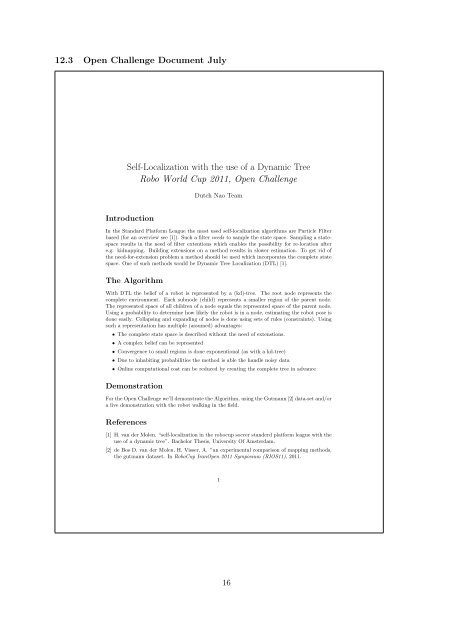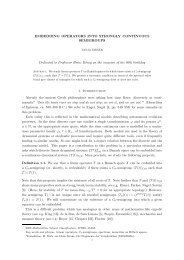Dutch Nao Team - Universiteit van Amsterdam
Dutch Nao Team - Universiteit van Amsterdam
Dutch Nao Team - Universiteit van Amsterdam
Create successful ePaper yourself
Turn your PDF publications into a flip-book with our unique Google optimized e-Paper software.
12.3 Open Challenge Document July<br />
Self-Localization with the use of a Dynamic Tree<br />
Robo World Cup 2011, Open Challenge<br />
Introduction<br />
<strong>Dutch</strong> <strong>Nao</strong> <strong>Team</strong><br />
In the Standard Platform League the most used self-localization algorithms are Particle Filter<br />
based (for an overview see [1]). Such a filter needs to sample the state space. Sampling a statespace<br />
results in the need of filter extentions which enables the possibility for re-location after<br />
e.g. kidnapping. Building extensions on a method results in slower estimation. To get rid of<br />
the need-for-extension problem a method should be used which incorporates the complete state<br />
space. One of such methods would be Dynamic Tree Localization (DTL) [1].<br />
The Algorithm<br />
With DTL the belief of a robot is represented by a (kd)-tree. The root node represents the<br />
complete environment. Each subnode (child) represents a smaller region of the parent node.<br />
The represented space of all children of a node equals the represented space of the parent node.<br />
Using a probability to determine how likely the robot is in a node, estimating the robot pose is<br />
done easily. Collapsing and expanding of nodes is done using sets of rules (constraints). Using<br />
such a representation has multiple (assumed) ad<strong>van</strong>tages:<br />
• The complete state space is described without the need of extenstions.<br />
• A complex belief can be represented<br />
• Convergence to small regions is done exponentional (as with a kd-tree)<br />
• Due to inhabiting probabilities the method is able the handle noisy data<br />
• Online computational cost can be reduced by creating the complete tree in ad<strong>van</strong>ce<br />
Demonstration<br />
For the Open Challenge we’ll demonstrate the Algorithm, using the Gutmann [2] data-set and/or<br />
a live demonstration with the robot walking in the field.<br />
References<br />
[1] H. <strong>van</strong> der Molen. “self-localization in the robocup soccer standerd platform league with the<br />
use of a dynamic tree”. Bachelor Thesis, University Of <strong>Amsterdam</strong>.<br />
[2] de Bos D. <strong>van</strong> der Molen. H. Visser, A. ”an experimental comparison of mapping methods,<br />
the gutmann dataset. In RoboCup IranOpen 2011 Symposium (RIOS11), 2011.<br />
1<br />
16

















